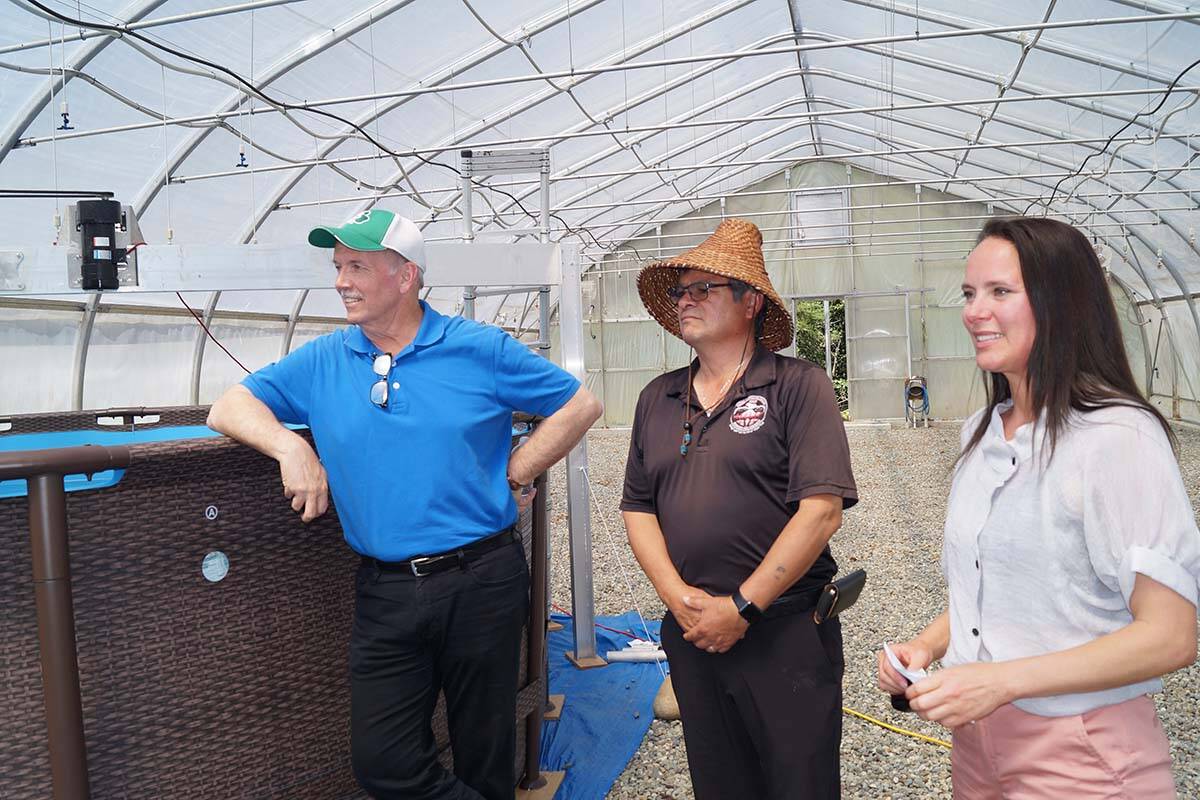The T’Sou-ke Nation’s greenhouses are cultivating an innovative approach to significantly reducing methane gas production by livestock.
On Monday, Premier John Horgan joined T’Sou-ke Nation Chief Gordie Planes and Tamara Loiselle to tour a facility that would significantly reduce methane emissions.
Loiselle is the founder and chief operating officer of Synergraze Inc., a Canadian company that is commercializing a livestock feed additive that could significantly reduce methane emissions from cattle, sheep, chickens, bison and sheep.
ALSO READ: T’Sou-ke Nation grows wasabi to new heights
One of the three greenhouses on Sooke Road operated by the T’Sou-ke Nation is home to the demonstration project that involves producing seaweed and algae in tanks harvested from seeds from the ocean that are then used as a livestock feed additive that can drastically reduce methane emissions.
“We’re producing something that can have a global impact while making Canadian cattle producers more competitive,” Loiselle said. “One cow, on average, produces one ton of CO2 equivalent a year. Using a tiny bit of additive with just B.C. cattle would eliminate the equivalent of one million cars on the road a year.”
The facility in Sooke alone will feed 135,000 cattle in a feedlot. Imagine the reduction in methane that’s possible considering there are 1.4 billion head of cattle globally, Loiselle added.
“Chief Planes and the T’Sou-ke have really embraced this project and our partnership,” she said.
Planes said the connection forged with Loiselle on the demonstration project – in the greenhouse previously used for producing wasabi – has been a great experience.
“It’s an opportunity to do something that has a great positive impact on Mother Earth,” Planes said. “That’s something we strive for our children and our future. It’s going to take our children to change the world. Innovation like this is part of getting us where we want to go, with the ripple effect of more investment in our oceans.”
Horgan said the project is significant in many ways, especially in view of the challenges facing the cattle industry.
“It’s keeping pace with the needs of a changing world,” Horgan said. “It could increase production in the cattle industry and reduce the impact of the amount of land required for grazing. Methane is a big challenge, and capturing it and using it for other purposes is a major game changer.”
Emissions from cattle account for 30 per cent of all methane emissions globally. Although methane is the second most abundant greenhouse gas emitted into the atmosphere by human activity after carbon monoxide, methane is 25 times more potent as a heat-trapping gas than carbon dioxide.
Loiselle is from a ranching family in B.C. and has a background in environmental science from the Faculty of Agriculture at the University of Alberta. She was a faculty member at Mount Royal University and taught science in the Indigenous Education program for more than a decade. Loiselle received the Queen’s Diamond Jubilee Medal for her work with Indigenous communities and the environment in 2010 and has also been recognized by TIME Magazine as a Hero Mom of the Year.
Benefits touted by Synergraze in addition to greenhouse gas mitigation include increasing cattle rate of weight gain by as much as 50 per cent, and increasing profits for cattle producers through reductions in feed cost. Voluntary methane mitigation in cattle production also qualifies for carbon credits in some jurisdictions,
According to Synergraze’s research, if 40 per cent of Canada’s cattle were supplemented with Synergraze, methane emissions could be reduced by 8.9 million tonnes/CO2 a year.
Research and development are gearing toward a large land-based plant within a year.
editor@sookenewsmirror.com
Like us on Facebook and follow us on Twitter
British ColumbiaJohn HorganLocal Newsmethane regulationsSookeWest Shore

